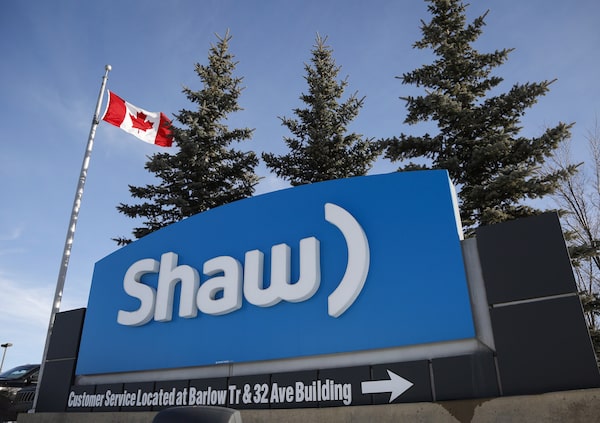
A Shaw Communications sign at the company's headquarters in Calgary, Jan. 14, 2015.Jeff McIntosh/The Canadian Press
Shaw Communications Inc. SJR-A-X reported declines in revenue and profit during the second quarter as it awaits approval from two more regulators for its $26-billion combination with Rogers Communications Inc. RCI-A-T
Shaw had $1.36-billion in revenue for the three-month period ended Feb. 28, down 2 per cent from a year ago when it brought in $1.39-billion.
Its net income for the quarter came to $196-million, down 9.7 per cent from $217-million during the same period last year. The profit amounted to 39 cents per diluted share, compared with 43 cents.
Shaw added 8,632 postpaid wireless subscribers during the quarter – significantly fewer than the 75,069 it added during the same quarter last year.
The company attributed the year-over-year decline to heightened competition during the holiday season, a limited supply of key wireless devices, and a change to its bundled internet and Shaw Mobile wireless service offering.
Edward Jones analyst Dave Heger called the results disappointing and noted that Shaw may have pulled back on wireless promotional activity over the holidays.
“If you look across the industry, that’s when everyone has their strongest growth – the best subscriber additions typically are around the holiday season,” Mr. Heger said in an interview.
He added that Telus Corp., BCE Inc.’s Bell Canada and Rogers Communications all reported strong wireless customer additions over the holidays, indicating that Shaw’s Freedom Mobile lost market share to competitors.
“They may just be getting anxious to get [the Rogers deal] closed and may have taken their eye off the ball to some degree,” Mr. Heger said, adding that the takeover is still “not a done deal.”
“They’re going to need to line up a buyer for [Freedom] to close the deal, so [these results] could make a potential buyer step back and recalculate what this business might be worth,” Mr. Heger said.
Shaw also added 8,260 prepaid mobile-phone customers, up from 7,228 during the same quarter last year. Postpaid subscribers are those who are billed at the end of the month for the services they used, versus prepaid customers, who pay upfront for wireless services.
The company also pulled back spending on its wireless network while increasing its cable network investments. Shaw spent $30-million on its wireless network during the quarter, down 57.7 per cent from a year ago when it spent $71-million. Its wireline capital expenditures came to $219-million, up 22.3 per cent from $179-million.
Last month, the Canadian Radio-television and Telecommunications Commission approved the transfer of Shaw’s broadcasting services to Rogers. The takeover still requires approval from the Competition Bureau and Innovation, Science and Economic Development Canada.
Innovation Minister François-Philippe Champagne has said he won’t permit Rogers to acquire all of Shaw’s wireless licences. Doing so would go against Ottawa’s desire to preserve competition in the wireless sector, Mr. Champagne said in a statement in March.
Brad Shaw, Shaw’s chief executive officer, called the CRTC approval a “critical milestone,” and said his company is continuing to work with Rogers to obtain the remaining regulatory approvals. Rogers and Shaw expect the deal to close in the first half of this year.
“Our team continues to execute on our strategic business priorities of delivering profitable growth while continuing to invest in the strength and breadth of our networks. It is this solid and strategic foundation that, combined with Rogers, will deliver new and better technologies to more Canadians,” Mr. Shaw said in a statement.
Your time is valuable. Have the Top Business Headlines newsletter conveniently delivered to your inbox in the morning or evening. Sign up today.